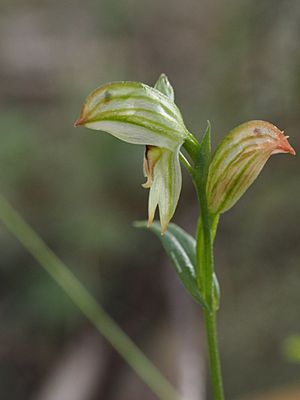Pterostylis major facts for kids
Quick facts for kids Pterostylis major |
|
|---|---|
 |
|
| Pterostylis major growing at the type location | |
| Scientific classification | |
| Genus: |
Pterostylis
|
| Species: |
major
|
| Synonyms | |
|
Bunochilus major D.L.Jones |
|
Pterostylis major is a special plant from the orchid family. It is found only in New South Wales, Australia, especially in the Northern Tablelands. This means it is endemic to that area.
Like other "greenhood" orchids, this plant looks different depending on if it's flowering or not. Plants that are not flowering have a group of leaves called a rosette on a short stem. But when the plant flowers, it loses its rosette. Instead, it grows a tall stem with up to eleven bright green flowers that have darker stripes.
Contents
About the Pterostylis major Orchid
Pterostylis major is a plant that grows in the ground. It is a perennial herb, which means it lives for many years. It also dies back each year, like a deciduous tree losing its leaves. It has an underground tuber for storing food.
Non-Flowering Plants
Non-flowering plants have a rosette of three to six leaves. Each leaf is about 8–40 mm (0.3–2 in) long and 4–8 mm (0.2–0.3 in) wide. These leaves grow on a stalk that is 50–120 mm (2–5 in) tall.

Flowering Plants
Flowering plants do not have a rosette of leaves. Instead, they grow a tall flowering stem, which can be 120–650 mm (5–30 in) high. This stem has five to seven long, narrow leaves. These stem leaves are 15–95 mm (0.6–4 in) long and 2–8 mm (0.08–0.3 in) wide.
The flowers are spaced out along the stem. They are 14–18 mm (0.6–0.7 in) long and 6.5–8.5 mm (0.26–0.33 in) wide. They are a bright, see-through green with darker green stripes.
Flower Parts
The top sepal (a leaf-like part) and the petals (the colorful parts) join together. They form a hood called the "galea" over the central part of the flower. This top sepal is 12–15 mm (0.5–0.6 in) long and slightly curved. The petals are oblong, 13–15 mm (0.5–0.6 in) long, and about 3 mm (0.1 in) wide. They are also gently curved.
The two side sepals are joined together. They form a single part that is 13–16 mm (0.5–0.6 in) long and 6.5–8.5 mm (0.26–0.33 in) wide. It has a notch in the middle that is 4–5.5 mm (0.16–0.22 in) deep.
The labellum is a special lip-like petal. It is egg-shaped to oblong, 5.5–7 mm (0.2–0.3 in) long, and 2–3 mm (0.08–0.1 in) wide. It is pale to yellowish green with a brown or black line down its middle.
This orchid flowers from April to September.
Naming the Pterostylis major Orchid
This plant was first officially described in 2006 by a botanist named David Jones. He first named it Bunochilus major. The description was published in a science journal called Australian Orchid Research. The plant was found near Point Lookout Road.
Later, in 2010, another botanist named Gary Backhouse changed its name to Pterostylis major.
Why the Name Major?
The second part of its name, major, comes from a Latin word. It means "large" or "great". This name was chosen because this orchid is bigger than a similar plant called Pterostylis longifolia.
Where Pterostylis major Grows
Pterostylis major grows among grasses and shrubs. It likes to live in tall forests. You can find it on the New England Tableland and as far south as the Barrington Tops.

